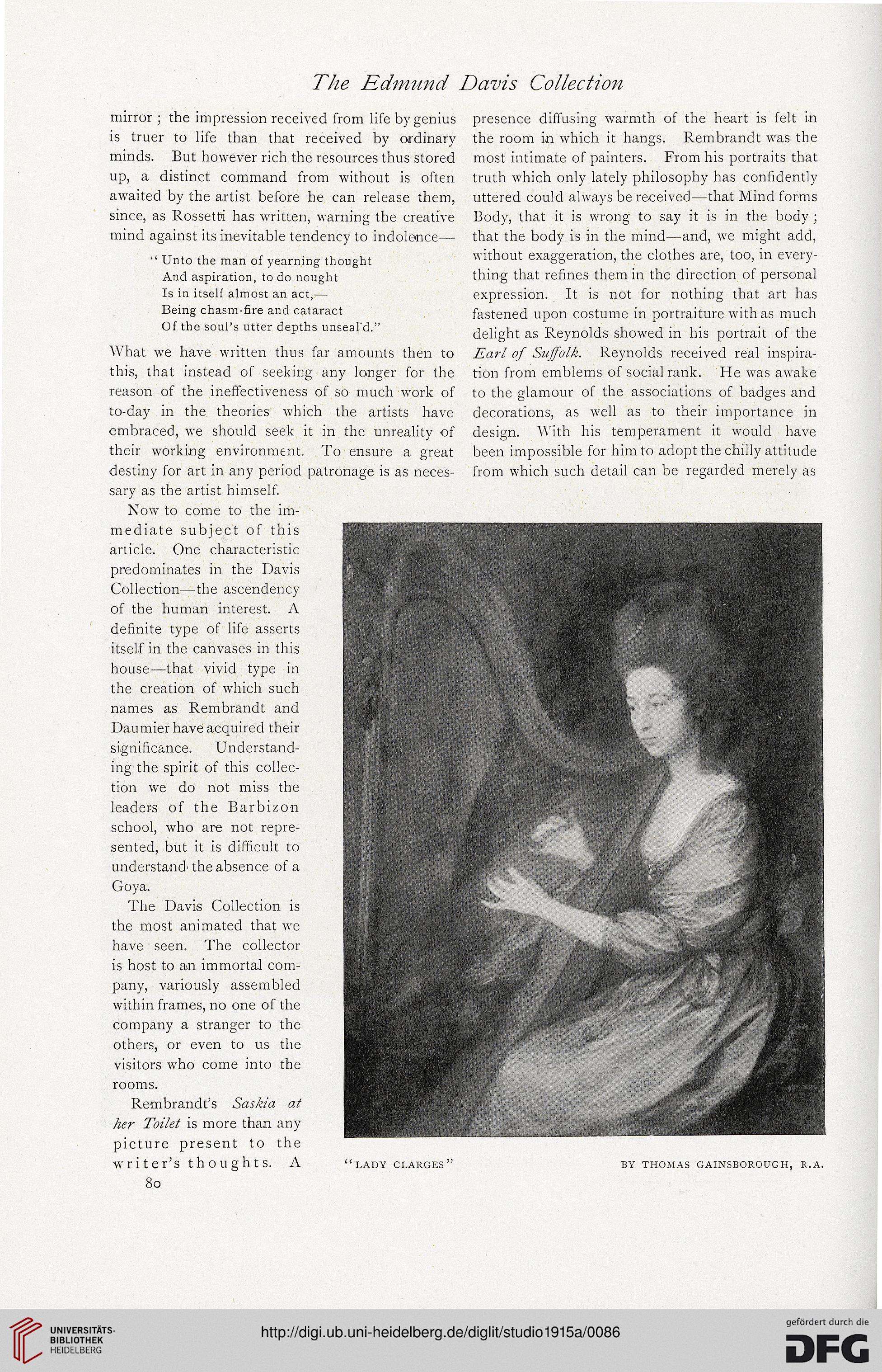The Edmund Davis Collection
mirror ; the impression received from life by genius
is truer to life than that received by ordinary
minds. But however rich the resources thus stored
up, a distinct command from without is often
awaited by the artist before be can release them,
since, as Rossetti has written, warning the creative
mind against its inevitable tendency to indolence—
“ Unto the man of yearning thought
And aspiration, to do nought
Is in itself almost an act,^
Being chasm-fire and cataract
Of the soul’s utter depths unseal'd.”
What we have written thus far amounts then to
this, that instead of seeking any longer for the
reason of the ineffectiveness of so much work of
to-day in the theories which the artists have
embraced, we should seek it in the unreality of
their working environment. To ensure a great
destiny for art in any period patronage is as neces-
sary as the artist himself.
Now to come to the im-
mediate subject of this
article. One characteristic
predominates in the Davis
Collection—the ascendency
of the human interest. A
definite type of life asserts
itself in the canvases in this
house—that vivid type in
the creation of which such
names as Rembrandt and
Daumier have acquired their
significance. Understand-
ing the spirit of this collec-
tion we do not miss the
leaders of the Barbizon
school, who are not repre-
sented, but it is difficult to
understand-the absence of a
Goya.
The Davis Collection is
the most animated that we
have seen. The collector
is host to an immortal com-
pany, variously assembled
within frames, no one of the
company a stranger to the
others, or even to us the
visitors wffio come into the
rooms.
Rembrandt’s Saskia at
her Toilet is more than any
picture present to the
writer’s thoughts. A
80
presence diffusing warmth of the heart is felt in
the room in wffiich it hangs. Rembrandt was the
most intimate of painters. From his portraits that
truth which only lately philosophy has confidently
uttered could always be received—that Mind forms
Body, that it is wrong to say it is in the body ;
that the body is in the mind—and, we might add,
without exaggeration, the clothes are, too, in every-
thing that refines them in the direction of personal
expression. It is not for nothing that art has
fastened upon costume in portraiture with as much
delight as Reynolds showed in his portrait of the
Earl of Suffolk. Reynolds received real inspira-
tion from emblems of social rank. He ivas awake
to the glamour of the associations of badges and
decorations, as well as to their importance in
design. With his temperament it would have
been impossible for him to adopt the chilly attitude
from which such detail can be regarded merely as
“ LADY CLARGES”
BY THOMAS GAINSBOROUGH, R.A.
mirror ; the impression received from life by genius
is truer to life than that received by ordinary
minds. But however rich the resources thus stored
up, a distinct command from without is often
awaited by the artist before be can release them,
since, as Rossetti has written, warning the creative
mind against its inevitable tendency to indolence—
“ Unto the man of yearning thought
And aspiration, to do nought
Is in itself almost an act,^
Being chasm-fire and cataract
Of the soul’s utter depths unseal'd.”
What we have written thus far amounts then to
this, that instead of seeking any longer for the
reason of the ineffectiveness of so much work of
to-day in the theories which the artists have
embraced, we should seek it in the unreality of
their working environment. To ensure a great
destiny for art in any period patronage is as neces-
sary as the artist himself.
Now to come to the im-
mediate subject of this
article. One characteristic
predominates in the Davis
Collection—the ascendency
of the human interest. A
definite type of life asserts
itself in the canvases in this
house—that vivid type in
the creation of which such
names as Rembrandt and
Daumier have acquired their
significance. Understand-
ing the spirit of this collec-
tion we do not miss the
leaders of the Barbizon
school, who are not repre-
sented, but it is difficult to
understand-the absence of a
Goya.
The Davis Collection is
the most animated that we
have seen. The collector
is host to an immortal com-
pany, variously assembled
within frames, no one of the
company a stranger to the
others, or even to us the
visitors wffio come into the
rooms.
Rembrandt’s Saskia at
her Toilet is more than any
picture present to the
writer’s thoughts. A
80
presence diffusing warmth of the heart is felt in
the room in wffiich it hangs. Rembrandt was the
most intimate of painters. From his portraits that
truth which only lately philosophy has confidently
uttered could always be received—that Mind forms
Body, that it is wrong to say it is in the body ;
that the body is in the mind—and, we might add,
without exaggeration, the clothes are, too, in every-
thing that refines them in the direction of personal
expression. It is not for nothing that art has
fastened upon costume in portraiture with as much
delight as Reynolds showed in his portrait of the
Earl of Suffolk. Reynolds received real inspira-
tion from emblems of social rank. He ivas awake
to the glamour of the associations of badges and
decorations, as well as to their importance in
design. With his temperament it would have
been impossible for him to adopt the chilly attitude
from which such detail can be regarded merely as
“ LADY CLARGES”
BY THOMAS GAINSBOROUGH, R.A.




